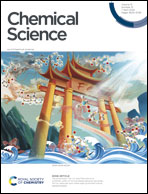Simultaneously enhancing organic phosphorescence quantum yields and lifetimes for triphenylphosphine salt doped polymer films†
Abstract
Simultaneously enhancing the quantum yields and luminescence lifetimes of organic persistent room temperature phosphorescence (RTP) molecules is a priority in the organic photonic area, but it remains a formidable challenge. Here, an effective strategy was proposed to improve both quantum efficiencies and emission decay times for phosphorescent triphenylphosphine salts. This approach involves integrating an electron donor unit into a triphenylphosphine salt via an alkyl chain. This structure facilitates an intermediate through-space charge transfer excited state, which enhances the intersystem crossing process to boost RTP performance. Moreover, the electron donor moiety contributes additional triplet excitons to the triphenylphosphine salts through triplet-to-triplet energy transfer, substantially increasing the population of triplet excitons. Specifically, compared to butyl(naphthalen-1-yl) diphenylphosphonium bromide (Φphos. = 4.9% and τ = 255.79 ms), (2-(9H-carbazol-9-yl)ethyl)(naphthalen-1-yl)diphenylphosphonium bromide demonstrates a higher phosphorescence quantum yield of 19.6% and an extended emission lifetime of 800.59 ms. This advancement lays the groundwork for developing high-performance organic RTP materials, unlocking new possibilities for advanced photonic applications.



 Please wait while we load your content...
Please wait while we load your content...